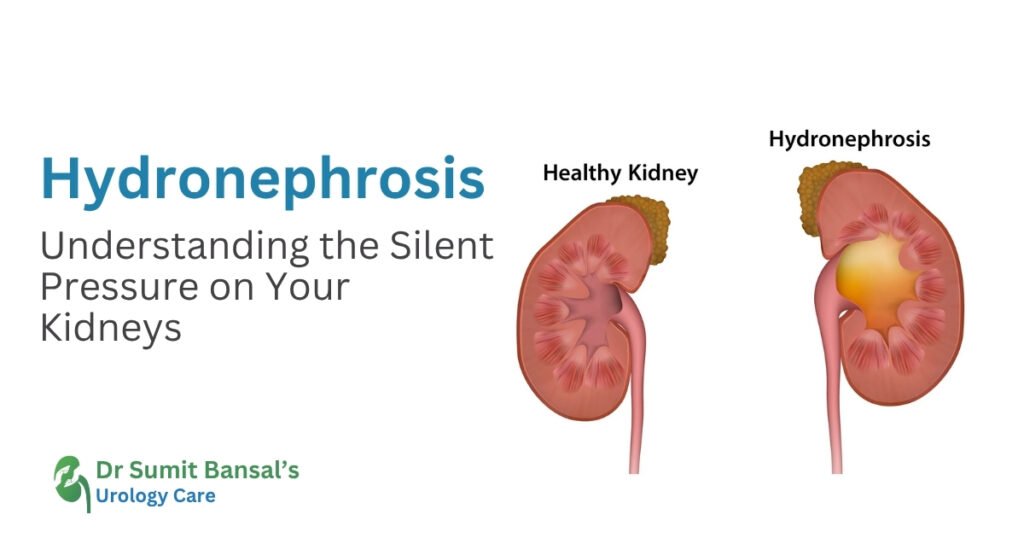Introduction: The Hidden Threat to Your Kidney Health
Have you ever heard of hydronephrosis? It might not be a commonly discussed condition, but it’s one that could silently affect your kidney function without noticeable early signs. Hydronephrosis refers to the swelling of one or both kidneys due to a build-up of urine. Left untreated, it can lead to long-term kidney damage and complications. As a Urologist and Kidney Transplant Surgeon, I, Dr. Sumit Bansal, often come across patients who are unaware of this silent condition until it becomes severe.
What Is Hydronephrosis?
Hydronephrosis occurs when urine cannot drain properly from the kidney to the bladder due to an obstruction or reflux. This causes urine to back up, leading to kidney swelling and increased internal pressure — a silent but harmful process.
Causes of Hydronephrosis
Hydronephrosis is not a disease in itself, but a consequence of other conditions. Common causes include:
Kidney stones: Block urine flow, especially at the ureter.
Urinary tract infections (UTIs): Can cause inflammation and blockage.
Enlarged prostate (in men): Common in older age.
Congenital abnormalities: Often found in infants or during prenatal ultrasound.
Pregnancy: Uterine pressure can affect urinary drainage temporarily.
Tumors: In or near the urinary tract, obstructing flow.
Symptoms: Often Silent, Sometimes Alarming
Hydronephrosis can be asymptomatic, especially in early stages. However, as pressure builds, the following symptoms may appear:
Flank pain or lower back pain
Difficulty urinating or incomplete bladder emptying
Nausea or vomiting
Fever (especially if infection is present)
Swelling in the abdomen
Increased urge to urinate
Why You Shouldn’t Ignore It
Ignoring hydronephrosis can lead to progressive kidney damage. Chronic pressure damages the delicate filtering tissues of the kidney, reducing its ability to remove waste and regulate fluids — eventually risking kidney failure.
Diagnosis: How We Detect the Pressure
At Urology Care Clinic, we use a range of diagnostic tools to detect hydronephrosis early:
Ultrasound: A non-invasive imaging technique to identify swelling.
CT Scan: Offers detailed images to locate obstructions.
Urodynamic studies: Assess how well the bladder and urethra store and release urine.
Blood and urine tests: Help evaluate kidney function and detect infections.
Treatment: Addressing the Cause, Protecting the Kidney
The goal of treatment is to relieve the pressure and restore normal urine flow. Depending on the cause, treatment options include:
Medications: For infections or inflammation.
Catheterization or stenting: To bypass obstructions temporarily.
Surgical procedures: To remove stones, repair strictures, or treat tumors.
Prostate treatment: For cases related to BPH (Benign Prostatic Hyperplasia).
When to See a Urologist
If you’re experiencing persistent flank pain, frequent UTIs, or changes in urination, it’s time to consult a urologist. Early detection and treatment are key to preventing long-term damage.
Dr. Sumit Bansal
MCh (Urology), MS (General Surgery), MBBS
Uro-Oncosurgeon | Kidney Transplant Surgeon
📍 Practicing at Manipal Hospital, Gurugram & Dwarka
📞 Call: +91 9599 555 945
🌐 [Visit Urology Care Clinic Website (if available)]
Final Thoughts:
Hydronephrosis may be silent in its early stages, but its impact on kidney health is loud and clear. Regular check-ups and early diagnosis can help prevent serious complications. If you’re at risk or have a history of kidney issues, don’t wait. Let’s take proactive steps for a healthier urinary system.


